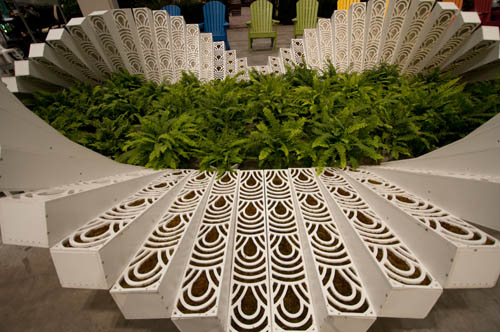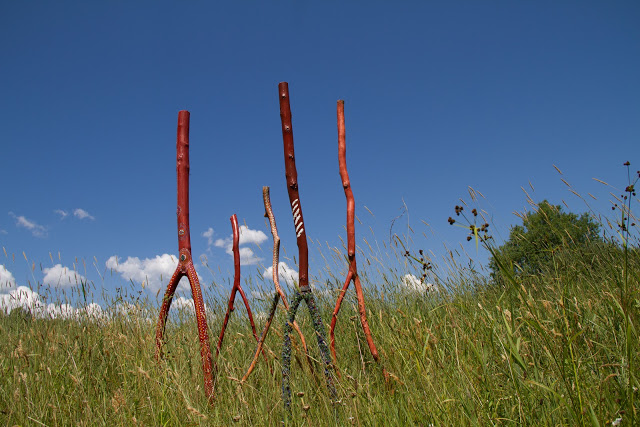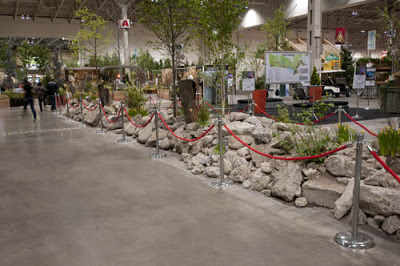An extra post, from Toronto
As I write, I’m on my way to Toronto to visit Canada Blooms, Canada’s largest garden show. I’m speaking tomorrow about using art in a garden
and am pleased to be doing this. I set myself a goal when I first started giving talks about gardens and garden design, and that goal was to speak at Canada Blooms. So, as of tomorrow afternoon, I’ll check off one item on my (increasingly long) list of things to do.
Two exceptions stick in my mind: Surface Deep, the moss curl from the Reford Gardens, located in Metis, Quebec,
 |
| Surface Deep. Photo thanks to Canada Blooms |
and Toronto landscape architect Victoria Taylor’s allusion to the urban landscape, Concrete Blooms Burst, a garden that combined re-cycled chunks of concrete with the occasional explosion of green.
A garden reflects the world in which it is created. It says something about the environment in which it exists, and about the person who created it. We can ‘read’ a garden and discover ideas about the past that are valuable in themselves, or that stimulate our creativity today. I’m trying to do that at Glen Villa, in The China Terrace and with installations like Abenaki Walking.
 |
| Abenaki Walking |
The poet Alexander Pope urged us to consult the ‘genius of the place.’ We’ve come to understand his counsel to mean we should consider the particularities of a site and take full advantage of what it has to offer. For me that definitely includes the history of the site. But history alone is inadequate. Taking full advantage of any site has to include the present moment.
 |
| Ryoan-ji garden, Kyoto. |
Others say they enjoy the excuse to spend time outside, playing in the dirt, nurturing what they’ve planted. Others search for the latest plant and hope their garden will wow the neighbours. And according to some garden historians, it has always been thus. (Think of Versailles and the Sun King, or Victorian plant hunters and the collectors who supported them.)
If a garden is to reflect the world in which it is created, if it is to say something about that world, our ideas about what a garden is have to take today’s world into account.
So, what to make of a garden ‘show’ like Canada Blooms, or the Chelsea Flower Show, or any of the many indoor and outdoor garden events held round the world? Do they enrich our ideas about what a garden is, or can be, or do they encourage us to stick to the past and to our familiar ideas?
Most of us live and garden in cities. Surely an ‘authentic’ response (to use Professor Jacobs’ terminology) is not to create some kind of wilderness fantasy in our back yards but to make a garden that is relevant today.
Do garden shows help us to do this? Should they? Or are they artificial reflections of fantasies that no long exist?
And where do flowers figure in the discussion?
 |
| Muscari blooming in the Dragon’s Tail at Glen Villa |
I have opinions, but I think I’ll wait to see what this year’s Canada Blooms has to offer before I put them out for inspection.
But count on it: more is to come on this topic … much more!







Hi Pat,
It was very nice to meet you today, and to read now, your impressions of Canada Blooms. I can’t agree with you more, it has been very disappointing for many years and if it wasn’t for the fact that I live close by and have a number of free tickets, I probably would not have been there today.
BTW, Victoria Taylor and Jonas Spring ( builder of last years project) are friends of mine and will be very glad to hear of your praises.
Thanks for following my blog, I have signed up to follow yours.
I emailed Victoria last year after the show, telling her how much I admired what she had done. So my praise won’t come as a surprise. But do pass it on.
And thanks for the lead to landscape lovers blog. Just read her last post and will definitely keep following he.